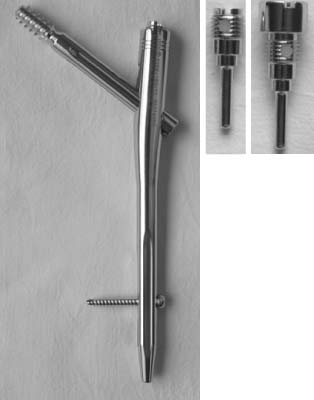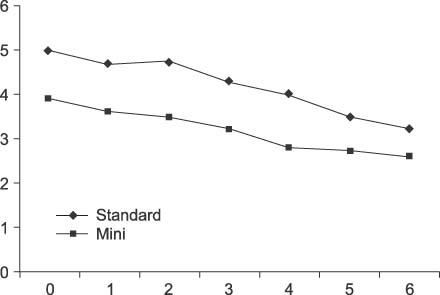J Korean Fract Soc.
2008 Jan;21(1):1-7. 10.12671/jkfs.2008.21.1.1.
Comparison Study of Intertrochanteric Fractures Treated with Intertrochanteric/subtrochanteric Fixation with a Standard vs a Mini-incision
- Affiliations
-
- 1Department of Orthopaedic Surgery, Yeungnam University Hospital, Daegu, Korea. ossoj@med.yu.ac.kr
- KMID: 1480956
- DOI: http://doi.org/10.12671/jkfs.2008.21.1.1
Abstract
-
PURPOSE: To evaluate the radiographic, clinical results between who had intertrochnateric fracture, treated with ITST with a standard or a mini-incision.
MATERIALS AND METHODS
We selected each 20 patients of intertrochanteric fracture which were treated with ITST with a standard incision or a mini-incision from June 2004 to July 2006. We compared of mean operative time, transfusion doses and postoperative VAS score between two groups. We evaluated the radiographic results by follow-up radiography and the clinical results with the mobility score of Parker and Palmer and Salvati and Wilson hip function scoring system.
RESULTS
Mean operative time, transfusion doses and postoperative VAS score were significantly less in the mini-incision there were 87.8 min., 2.0 pints and 4.2 for the standard group versus 40.3 min., 1.1 pints and 3.3 for the mini group. The radiographic results were not significantly different. Decrease of mobility score of Parker and Palmer and Salvati and Wilson hip function scoring system were similar.
CONCLUSION
Mini-incision significantly reduces operative time, transfusion doses and postoperative pain for fixation intertrochanteric fracture treated with ITST.
Figure
Cited by 1 articles
-
Treatment of the Intertrochanteric Femoral Fracture with Proximal Femoral Nail: Nailing Using the Provisional K-wire Fixation
Gu-Hee Jung
J Korean Fract Soc. 2011;24(3):223-229. doi: 10.12671/jkfs.2011.24.3.223.
Reference
-
1. Ahn SJ, Park JH. Proximal femoral nail (PFN) for the treatment of the femoral trochanteric fracture. J Korean Fract Soc. 2004; 17:7–12.
Article2. Baixauli F, Vicent V, Baixauli E, et al. A reinforced rigid fixation device for unstable intertrochanteric fractures. Clin Orthop Relat Res. 1999; 361:205–215.
Article3. Banan H, Al-Sabti A, Jimulia T, Hart AJ. The treatment of unstable extracapsular hip fractures with the AO/ASIF proximal femoral nail-our 60 cases. Injury. 2002; 33:401–405.
Article4. Baumgaertner MR, Curtin SL, Lindskog DM. Intramedullary versus extramedullary fixation for the treatment of intertrochanteric hip fractures. Clin Orthop Relat Res. 1998; 348:87–94.
Article5. Bridle SH, Patel AD, Bircher M, Calvert PT. Fixation of intertrochanteric fractures of the femur. A randomized prospective comparison of the gamma nail and the dynamic hip screw. J Bone Joint Surg Br. 1991; 73:330–334.6. Butt MS, Krikler SJ, Nafie S, Ali MS. Comparison of dynamic hip screw and gamma nail: a prospective, randomized controlled trial. Injury. 1995; 26:615–618.
Article7. Chevalley F, Gamba D. Gamma nailing of pertorchanteric and subtrochanteric fractures: clinical resuls of a series of 63 consecutive cases. J Orthop Trauma. 1997; 11:412–415.
Article8. Cummings SR, Rubin SM, Black D. The fracture of hip fractures in the unitied states. NUmbers, costs, and potential effects of postmenopausal estrogen. Clin Orthop Relat Res. 1990; 252:163–166.9. Dominique CR, Pierre Y. Use of an intramedullary HIp-Screw Compared with a Compression hip-Screw with a Plate for Intertrochanteric Femoral Fractures. A Prospective, Randomized Study of One Hundred patients. J Bone Joint Surg Am. 1998; 80:618–630.
Article10. Hardy DC, Descamps PY, Krallis P, et al. Use of an intramedullary hip-screw compared with a compression hip-screw with a plate for intertrochanteric femoral fractures. A prospective, randomized study of one hundres patients. J Bone Joint Surg Am. 1998; 80:618–630.11. Huskisson EC. Measurement of pain. Lancet. 1974; 2:1127–1131.
Article12. Jacobs RR, McClain O, Armstrong HJ. Internal fixation of intertrochanteric hip fractures: a clinical and biomechanical study. Clin Orthop Relat Res. 1980; 146:62–70.13. Janzing HM, Houben BJ, Brandt SE, et al. The gotfried percutaneous compression plate versus the dynamic hip screw in the treatment of pertrochanteric hip fractures: minimal invasive treatment reduces operative time and postoperative pain. J Trauma. 2002; 52:293–298.
Article14. Jensen JS. Determining factors for the mortality following hip fractures. Injury. 1984; 15:411–414.
Article15. Jung PH, Hwang JS, Kang S, Kwak JY. Comparative study of between intramedullary hip screw fixation group in the treatment of femoral intertrochanteric fracture. J Korean Hip Soc. 2004; 16:63–70.16. Kyle RF, Cabanela ME, Russell TA, et al. Fractures of the proximal part of the femur. Instr Course Lect. 1995; 44:227–253.
Article17. Lee SY, Park IH, Song KW, Shin SI, Lee JY, Cha JH. The result of proximal femoral nailing (PFN(R)) for unstable femoral peritrochanteric fracture. J Korean Soc Fract. 2003; 16:143–147.
Article18. Leung KS, So WS, Shen WY, Hui PW. Gamma nails and dynamic hip screw for peritrochanteric fractures. A randomized prospective study in elderly patients. J Bone Joint Surg Br. 1992; 74:345–351.19. Madsen JE, Naess L, Aune AK, Alho A, Ekeland A, Stromsoe K. Dynamic hip screw with trochanteric stabilizing plate in the treatment of unstable proximal femoral fractures: a comparative study with the Gamma nail and compression hip screw. J Orthop Trauma. 1998; 12:241–248.
Article20. Melton LJ 3rd, Ilstrup DM, Riggs BL, Beckenbaugh RD. Fifty-year trend in hip fracture incidence. Clin Orthop Relat Res. 1982; 162:144–149.
Article21. Moon DH, Choi JS, Kim GB, Kim JW, Kim KT. Treatment of unstable intertrochanteric femoral fracture with the AO/ASIF proximal femoral nail. J Korean Soc Fract. 2003; 16:136–142.
Article22. Pagnani MJ, Lyden JP. Postoperative femoral fracture after intramedullary fixation with a Gamma nail: case resport and review of the literature. J Trauma. 1994; 37:133–137.
Article23. Parker MJ, Palmer CR. A new mobility score for predicting mortality after hip fracture. J Bone Joint Surg Br. 1993; 75:797–798.
Article24. Radford PJ, Needoff M, Webb JK. A prospective randomised comparison of the dynamic hip screw and the gamma locking nail. J Bone Joint Surg Br. 1993; 75:789–793.
Article25. Rosenblum SF, Zuckerman JD, Kummer FJ, Tam BS. A biomechanical evaluation of the Gamma nail. J Bone Joint Surg Br. 1992; 74:352–357.
Article26. Sadowski C, Lubbeke A, Saudan M, Riand N, Stern R, Hoffmeyer P. Treatment of reverse oblique and transverse intertrochanteric fractures with use of an intramedullary nail or a 95 degrees screw-plate: a prospective, randomized study. J Bone Joint Surg Am. 2002; 84:372–381.
Article27. Salvati EA, Wilson PD Jr. Long-term results of femoral-head replacement. J Bone Joint Surg Am. 1973; 55:516–524.
Article28. Simpson AH, Varty K, Dodd CA. Sliding hip screws: modes of failure. Injury. 1989; 20:227–231.
Article29. Sohn OJ, Kim SD, Kim IW, Byun SJ. A comparative study of trochanteric fractures treated with the Intertrochanteric/subtrochanteric fixation or the proximal femoral nail. J Korean Fract Soc. 2006; 19:303–308.
Article30. Thorngren KG. Optimal treatment of hip fractures. Acta Orthop Scand Suppl. 1991; 241:Suppl. 31–34.
Article31. Zafiropoulos G, Pratt DJ. Fractured Gamma nail. Injury. 1994; 25:331–336.
Article
- Full Text Links
- Actions
-
Cited
- CITED
-
- Close
- Share
- Similar articles
-
- Surgical Treatment of Femur Intertrochanteric and Subtrochanteric Fracture
- A Comparative Study of Trochanteric Fractures Treated with the Intertrochanteric/subtrochanteric Fixation or the Proximal Femoral Nail
- External Fixation Under Local Anesthesia in Intertrochanteric Fracture Patients with High Anesthetic Risk: 3 Case Reports
- Characteristics and Surgical Outcomes of Intertrochanteric or Subtrochanteric Fractures Associated with Ipsilateral Femoral Shaft Fractures Treated with Closed Intramedullary Nailing: A Review of 31 Consecutive Cases over Four Years at a Single Institution
- Unstable Intertrochanteric Femoral Fracture Treated with Mini-incision Reduction Technique and Intramedullary Nail




